Improved ISRJ-Based Radar Target Echo Cancellation Using Frequency Shifting Modulation
Abstract
:1. Introduction
2. Review of Radar Target Echo Cancellation Based on ISRJ
2.1. Amplitude and Phase Characteristics of the ISRJ Signal
2.2. Target Echo Cancellation Using the ISRJ Signal
3. Improved ISRJ-Based Cancellation Method Using Frequency Shifting Modulation
4. Simulation Results and Analysis
4.1. Comparison of Required Jammer Power
4.2. Cancellation Performance Analysis by Numerical Simulations
4.2.1. Cancellation Performance with Ideal Amplitude Match
4.2.2. Cancellation Performance with Amplitude Mismatch
4.3. Measured SAR Data Experiments Verification
4.3.1. Cancellation Results
4.3.2. Evaluation of the Cancellation Performance
5. Conclusions
Author Contributions
Funding
Conflicts of Interest
References
- Skolnik. Introduction to Radar Systems; McGraw-Hill: Boston, MA, USA, 2001. [Google Scholar]
- Liu, Y.; Wang, W.; Pan, X.; Dai, D.; Feng, D. A frequency-domain three-stage algorithm for active deception jamming against synthetic aperture radar. IET Radar Sonar Navigat. 2014, 8, 639–646. [Google Scholar] [CrossRef]
- Xu, L.; Feng, D.; Wang, X. Improved synthetic aperture radar micro-Doppler jamming method based on phase-switched screen. IET Radar Sonar Navigat. 2016, 10, 525–534. [Google Scholar] [CrossRef]
- Zhang, R.; Cao, S. 3D imaging millimeter wave circular synthetic aperture radar. Sensors 2017, 17, 1419. [Google Scholar] [CrossRef] [PubMed]
- Wang, X.; Liu, J.; Zhang, W.; Fu, Q.; Liu, Z.; Xie, X. Mathematic principles of interrupted-sampling repeater jamming (ISRJ). Sci. China-Inf. Sci. 2006, 50, 891–901. [Google Scholar] [CrossRef]
- Feng, D.; Tao, H.; Yang, Y.; Liu, Z. Jamming dechirping radar using interrupted-sampling repeater. Sci. China-Inf. Sci. 2011, 54, 2138–2146. [Google Scholar] [CrossRef]
- Almslmany, A.; Cao, Q.; Wang, C. A new airborne self-protection jammer for countering ground radars based on sub-Nyquist. IEICE Electron. Express 2015, 12, 2138–2149. [Google Scholar] [CrossRef]
- Feng, D.; Xu, L.; Pan, X.; Wang, X. Jamming wideband radar using interrupted-sampling repeater. IEEE Trans. Aerosp. Electron. Syst. 2017, 53, 1341–1354. [Google Scholar] [CrossRef]
- Tai, N.; Cui, K.; Wang, C.; Yuan, N. The design of a novel coherent noise jammer against LFM radar. IEICE Electron. Express 2016, 13, 2138–2149. [Google Scholar] [CrossRef]
- Wu, X.; Wang, X.; Lu, H. Study of intermittent-sampling repeater jamming to SAR. J. Astronaut. 2009, 30, 2043–2048. [Google Scholar]
- Wang, W.; Pan, X.; Liu, Y.; Feng, D.J.; Fu, Q.X. Sub-Nyquist sampling jamming against ISAR with compressed sensing. IEEE Sensors J. 2014, 14, 3131–3136. [Google Scholar] [CrossRef]
- Pan, X.; Wang, W.; Feng, D.; Liu, Y.; Fu, Q.; Wang, G. On deception jamming for countering ISAR based on sub-Nyquist sampling. IET Radar Sonar Navigat. 2014, 8, 173–179. [Google Scholar] [CrossRef]
- Gong, S.; Wei, X.; Li, X. ECCM scheme against interrupted sampling repeater jammer based on time-frequency analysis. J. Syst. Eng. Electron. 2014, 25, 996–1003. [Google Scholar] [CrossRef]
- Meller, M. Cheap Cancellation of Strong Echoes for Digital Passive and Noise Radars. IEEE Trans. Signal Process 2012, 60, 2654–2659. [Google Scholar] [CrossRef]
- Lu, Y.; Fowler, R.; Tian, W.; Thompson, L. Enhancing Echo Cancellation via Estimation of Delay. IEEE Trans. Signal Process 2005, 53, 4159–4168. [Google Scholar]
- Wang, Y.; Zhao, G.; Wang, H. Echo cancelling algorithm for the LFM radar. J. Xidian Univ. 2008, 6, 1031–1035. [Google Scholar]
- Ufimtsev, P.Y. Comment on Diffraction Principles and Limitations of RCS Reduction Techniques. Proc. IEEE 1996, 85, 1830–1851. [Google Scholar] [CrossRef]
- Xu, S.; Xu, Y. Simulation analysis of an active cancellation stealth system. Optik 2014, 125, 5273–5277. [Google Scholar]
- Yang, X.; Zhao, W.; Huang, L. Calculation of RCS of targets and statistical analysis of cancellation effect. Chin. J. Radio Sci. 2002, 17, 88–92. [Google Scholar]
- Xiang, Y.; Qu, C.; Su, F.; Yang, M. Active Cancellation Stealth Analysis of Warship for LFM Radar. Proc. ICSP 2010, 17, 2109–2112. [Google Scholar]
- Xiang, Y.; Qu, C.; Li, B.; Hou, H. Simulation Research on Cancellation Stealth of Warship Based on Its Radar Scattering Properties. J. Syst. Simul. 2013, 25, 104–110. [Google Scholar]
- Wei, Y.; Zhang, J.; Li, Z. A novel successive cancellation method to retrieve sea wave components form spatio-temporal remote sensing image sequences. Remote Sens. 2016, 8, 607. [Google Scholar] [CrossRef]
- Feng, D.; Xu, L.; Wang, W.; Yang, H. Radar target echo cancellation using interrupted-sampling repeater. IEICE Electron. Express 2014, 11, 1–6. [Google Scholar] [CrossRef]
- Xu, L.; Feng, D.; Dai, D.; Pan, X.; Wang, X. A Dual-Antenna Active-Echo-Cancellation Method for Synthetic Aperture Radar. In Proceedings of the 10th European Conference on Antennas and Propagation (EuCAP), Davos, Switzerland, 10–15 April 2016; pp. 1–5. [Google Scholar]
- Wu, Q.; Liu, J.; Wang, J.; Zhao, F.; Xiao, S. Improved Active Echo Cancellation Against Synthetic Aperture Radar Based on Non periodic Interrupted Sampling Modulation. IEEE Sens. J. 2018, 18, 4453–4461. [Google Scholar] [CrossRef]
- Hanbali, S.; Kastantin, R. Technique to counter active echo cancellation of self-protection ISRJ. IET Electron. Lett. 2017, 53, 680–681. [Google Scholar] [CrossRef]
- Xu, L.; Feng, D.; Liu, Y.; Pan, X.; Wang, X. A three-stage active cancellation method against synthetic aperture radar. IEEE Sensors J. 2015, 15, 6173–6178. [Google Scholar] [CrossRef]
- Hanbali, S.; Kastantin, R. Countering a self-protection frequency-shifting jamming against LFM pulse compression radars. INTL J. Electron. Telecommun. 2017, 63, 145–150. [Google Scholar] [CrossRef]
- Yang, Y.; Zhang, W.M.; Yang, J.H. Study on frequency-shifting jamming to linear frequency modulation pulse compression radars. In Proceedings of the 2009 International Conference on Wireless Communications & Signal Processing, Nanjing, China, 13–15 November 2009; pp. 1–5. [Google Scholar]
- The Sandia Complex Image. 2006. Available online: https://www.sandia.gov/radar/complex-data/ (accessed on 10 December 2018).
- Franceschetti, G.; Guida, R.; Iodice, A.; Riccio, D.; Ruello, G. Efficient simulation of hybrid stripmap/spotlight SAR raw signals from extended scenes. IEEE Trans. Geosci. Remote Sens. 2004, 42, 2385–2396. [Google Scholar] [CrossRef]



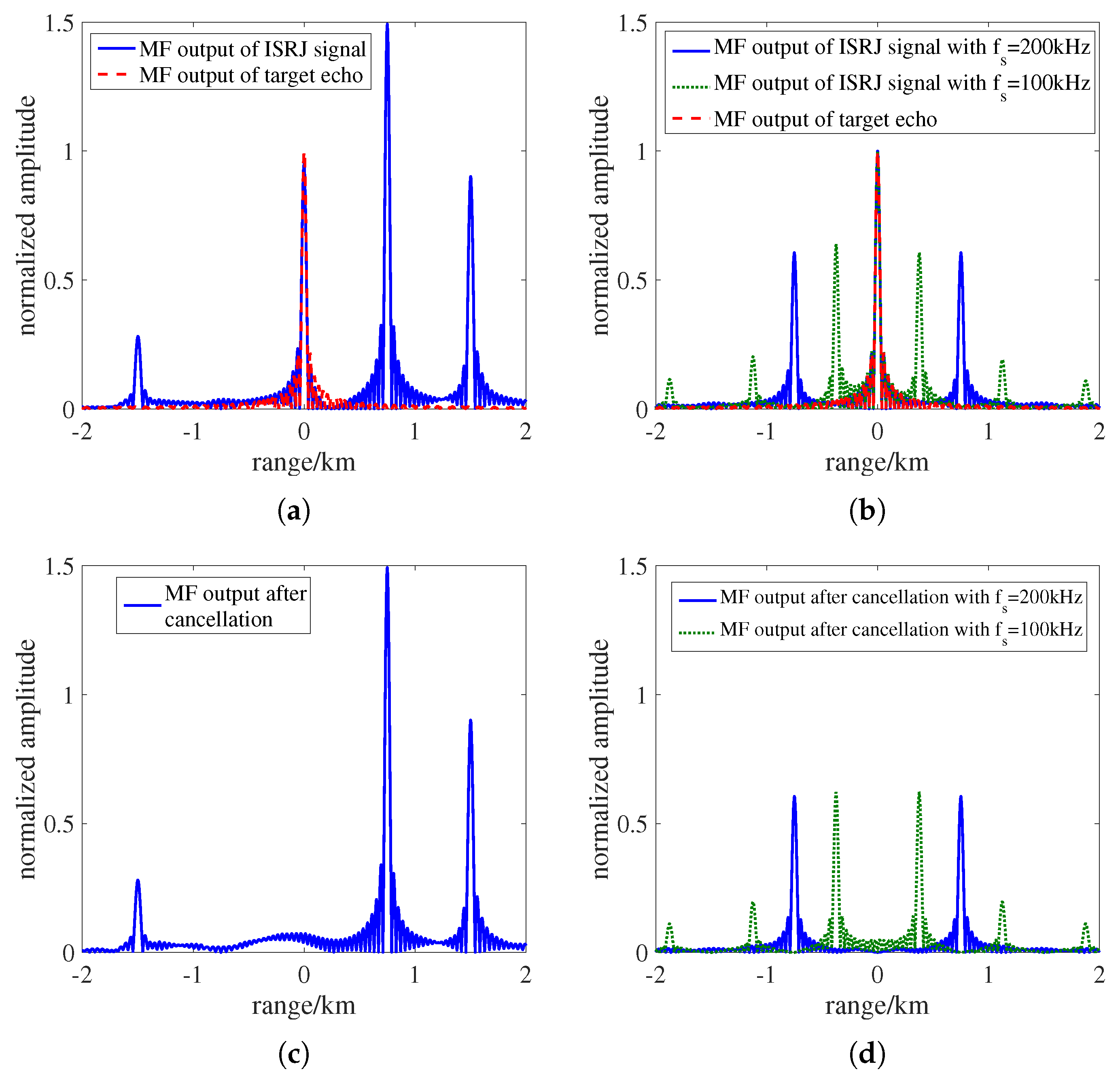
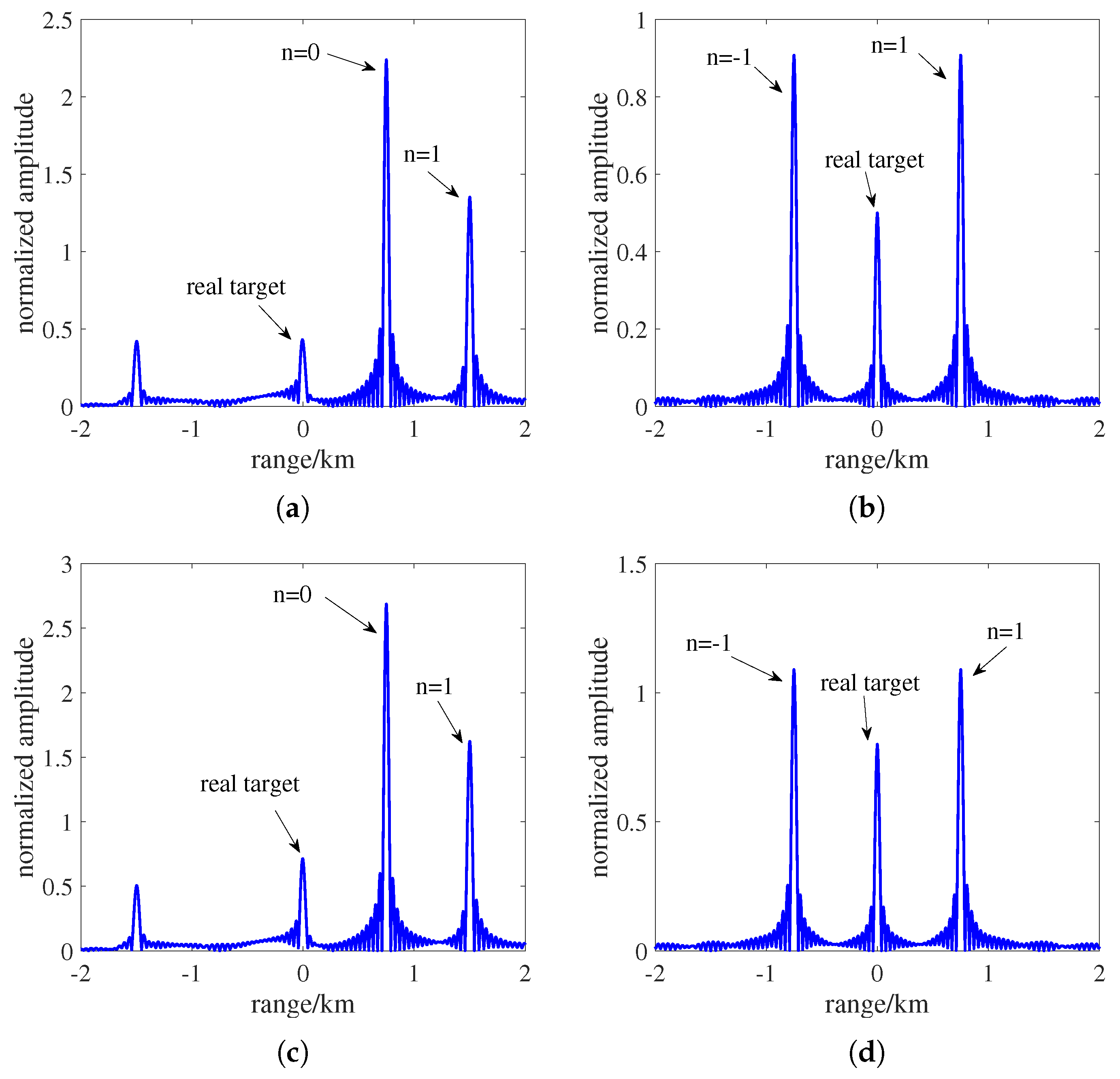
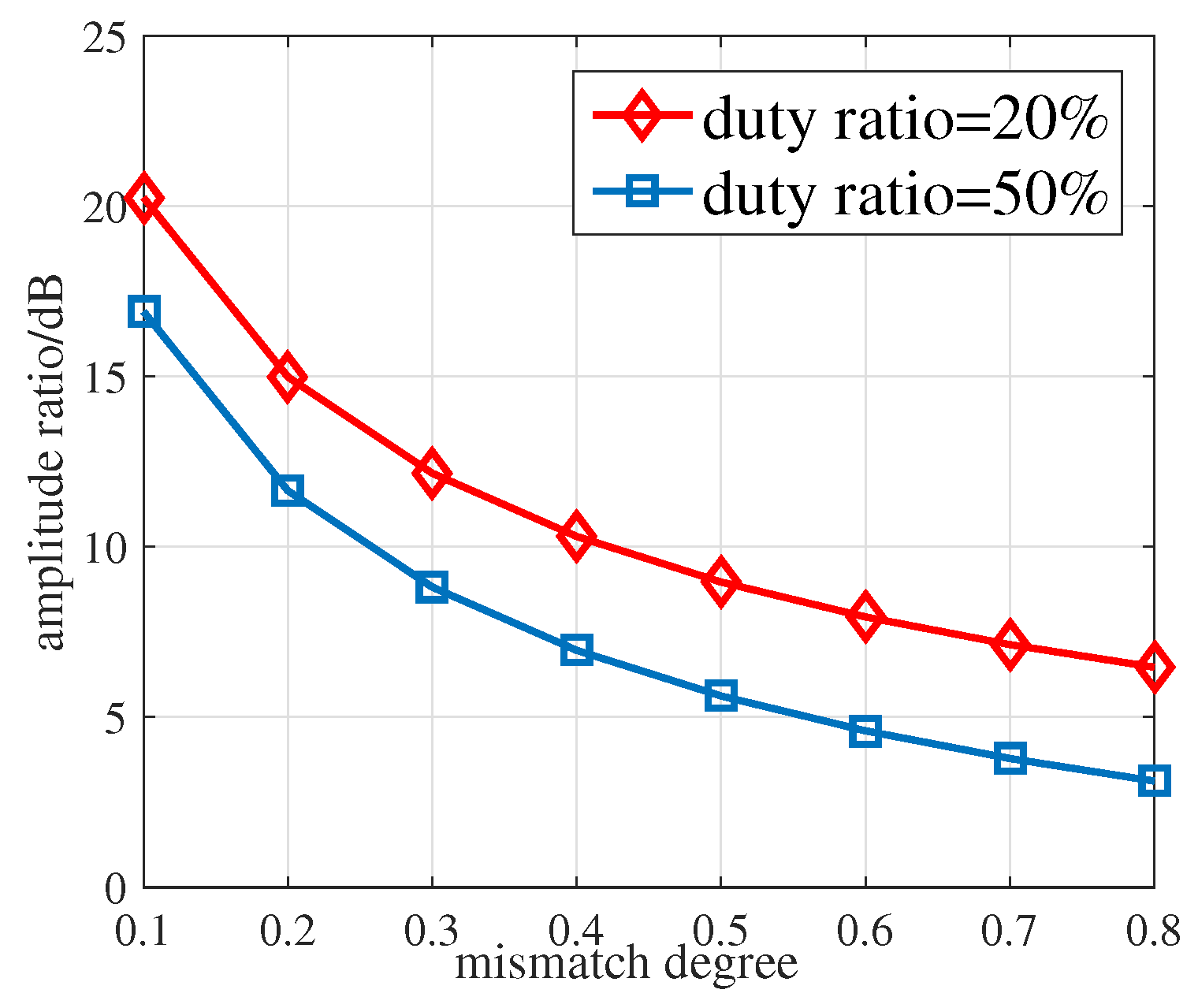
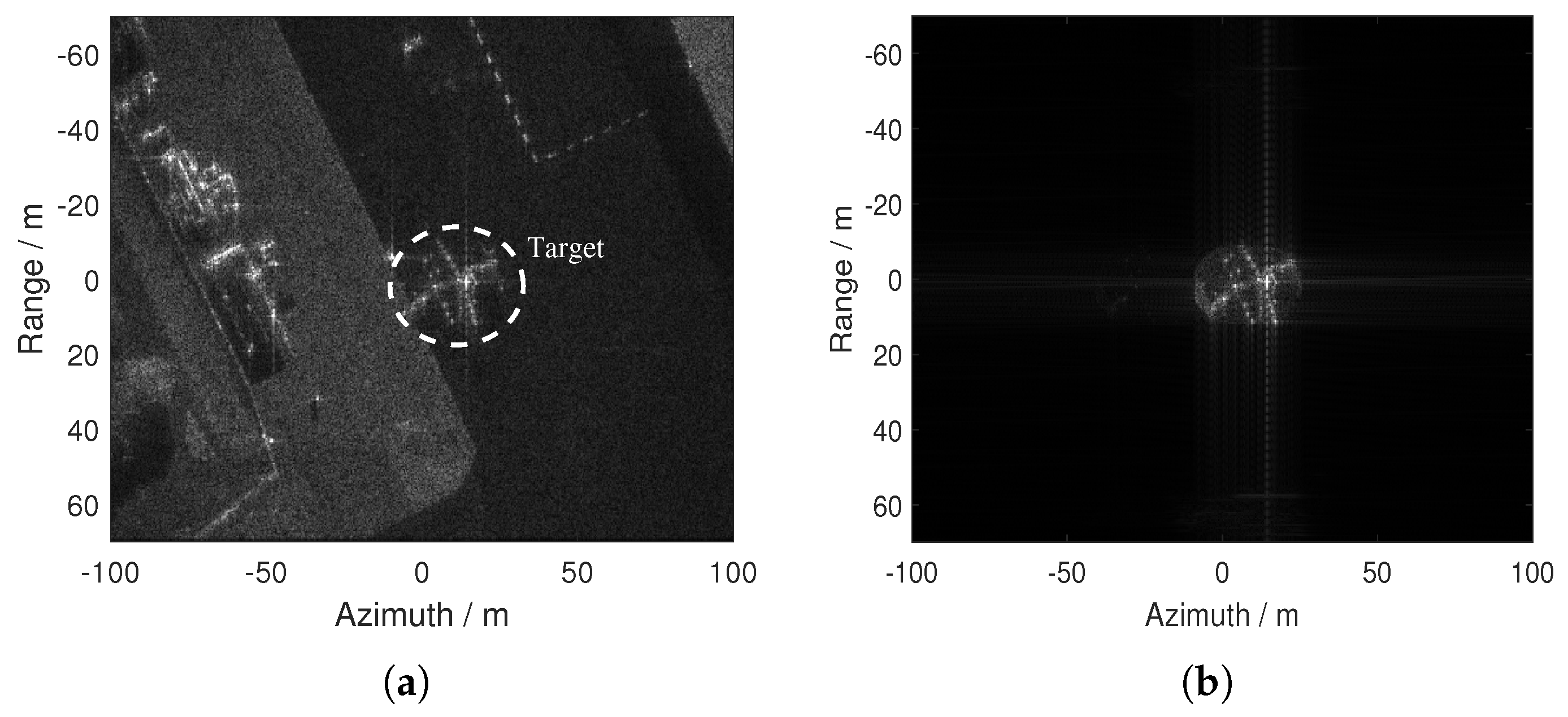

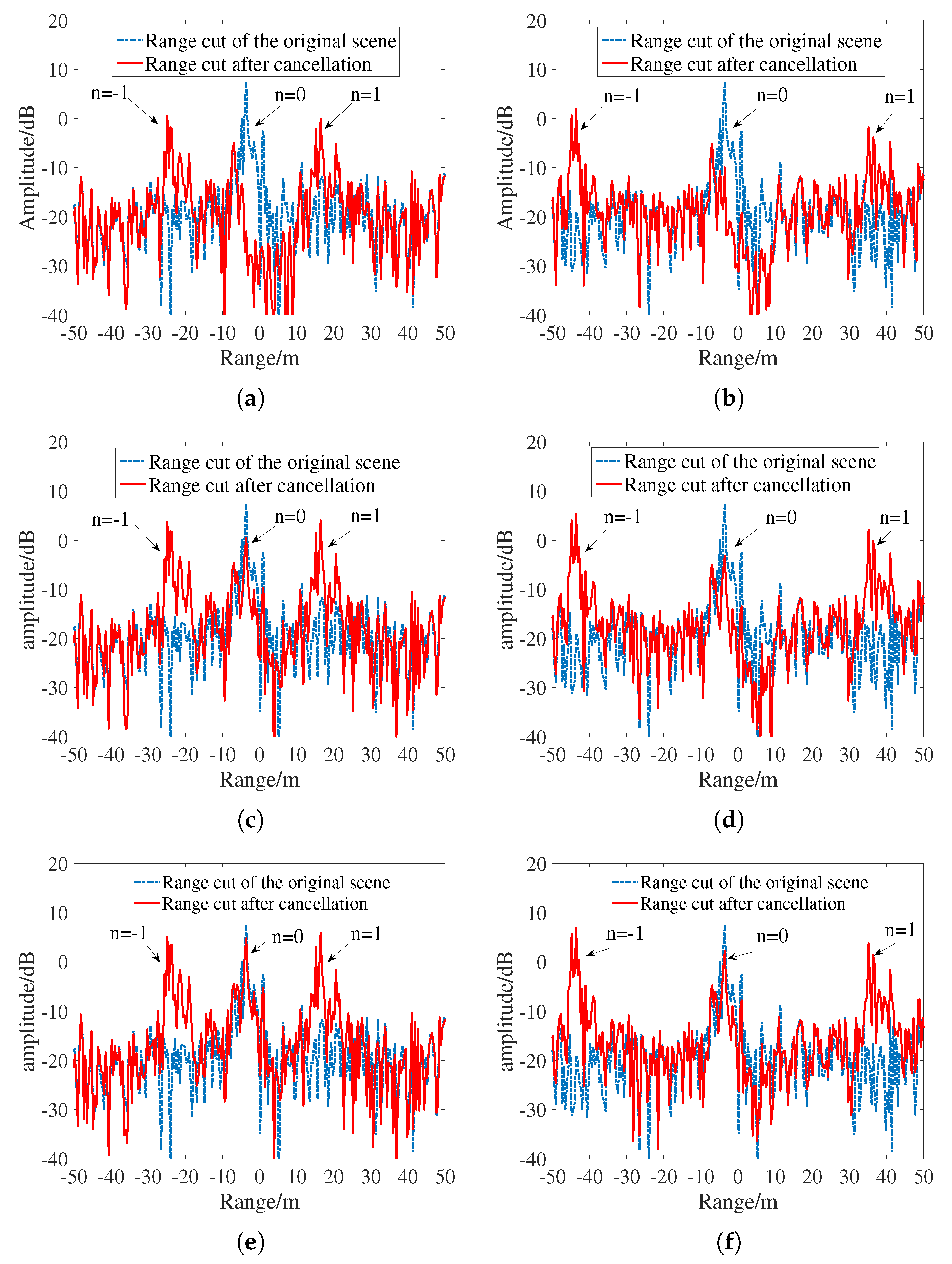
| Parameters | Value |
|---|---|
| radar antenna gain | 60 dB |
| peak power | 810 kW |
| pulse width | 100 us |
| chirp rate | Hz/s |
| target RCS | 0.1 m |
| Parameters | Value |
|---|---|
| Center frequency | 9 GHz |
| Resolution(range and azimuth) | 0.5 m×0.5 m |
| Platform velocity | 180 m/s |
| Odd number | 1001 |
| Chirp rate | 1.5 Hz/s |
© 2019 by the authors. Licensee MDPI, Basel, Switzerland. This article is an open access article distributed under the terms and conditions of the Creative Commons Attribution (CC BY) license (http://creativecommons.org/licenses/by/4.0/).
Share and Cite
Wu, Q.; Zhao, F.; Wang, J.; Liu, X.; Xiao, S. Improved ISRJ-Based Radar Target Echo Cancellation Using Frequency Shifting Modulation. Electronics 2019, 8, 46. https://doi.org/10.3390/electronics8010046
Wu Q, Zhao F, Wang J, Liu X, Xiao S. Improved ISRJ-Based Radar Target Echo Cancellation Using Frequency Shifting Modulation. Electronics. 2019; 8(1):46. https://doi.org/10.3390/electronics8010046
Chicago/Turabian StyleWu, Qihua, Feng Zhao, Junjie Wang, Xiaobin Liu, and Shunping Xiao. 2019. "Improved ISRJ-Based Radar Target Echo Cancellation Using Frequency Shifting Modulation" Electronics 8, no. 1: 46. https://doi.org/10.3390/electronics8010046





